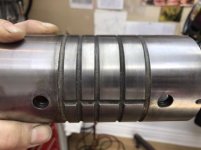Degull
Aluminum
- Joined
- Feb 3, 2014
- Location
- Toronto Canada
Hi everyone. I am novice looking for some advise on how to go about a thread repair on a sleeve for my Nichols Mill. I have the machine completely apart and addressing all the issues. Overall the machine is in great shape but there a couple of problems. The spindle outer sleeve has two 7/16-14 x 1/2" socket cap screws holding it inside the head of the mill. The threads in the sleeve are almost all gone, maybe one or two threads left. The stock screws not long enough anymore to reach the threads and cannot be tightened. The sleeve looks like it has been hardened and ground.
I could use longer screws but still only one thread holding the screw in. This might work because the screws only stop the outer spindle from moving much like a dowel pin. I am wondering what other options?



I could use longer screws but still only one thread holding the screw in. This might work because the screws only stop the outer spindle from moving much like a dowel pin. I am wondering what other options?






